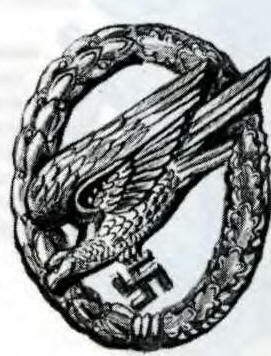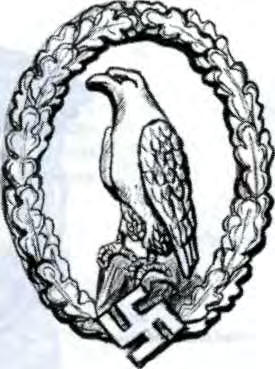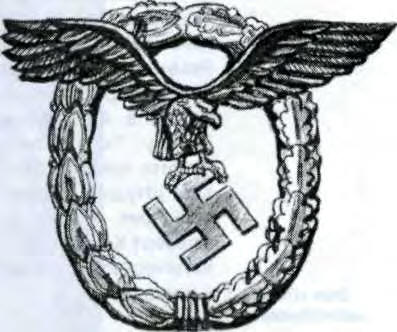

Online collections
monedastodas.com
All collections » Awards » German Third Reich air forces

Anti-aircraft artillery badge, Air Force version
Established on January 10, 1941 in the Air Force and on April
18, 1941 in the Ground Forces.
The badge was issued to personnel and support personnel of anti-aircraft
artillery units of the German air force and ground forces. Before the
introduction of a similar badge in the ground forces, it was also awarded to
anti-aircraft gun crews for the destruction of enemy ground targets.
Badges were awarded to the platoon commander, commander and crew members of the
anti-aircraft gun after the destruction of the fifth enemy aircraft. Commanders
of anti-aircraft artillery companies or batteries could receive this distinction
if more than half of the crews subordinate to them had already been awarded this
badge. Commanders of anti-aircraft artillery units were awarded similarly: at
least half of the officers subordinate to them were required to have a badge.
A silver-gray oval of oak leaves overlaid with images of an
88mm anti-aircraft gun and an Imperial (Air Force) eagle. Size 57x44 mm.
Fastening - pin.

Sign "Skydiver"
Air Force version
Established on September 1, 1937. The badge was received by
all military personnel of the airborne units of the German army who received
parachute training.
The badge was awarded until the airborne units were transferred to the Air
Force. After this, all paratroopers began to receive a version of the Air Force
Parachutist badge, which was established on November 5, 1936.
A gilded bronze wreath made of oak leaves, inside of which was a silver-plated
diving eagle. Above it is a small gilded imperial eagle.
The Air Force version was a bronze wreath of oak and laurel leaves, inside of
which was a gilded diving eagle with a swastika in its talons. Size 55x42 mm.
Fastening - pin.

Established on March 26, 1936 to reward Air Force veterans,
primarily those who participated in the First World War.
Worn exclusively with the “Pilot” sign. Allowed also worn on civilian clothes.
Bronze silver-plated wreath of oak leaves with a black image of an eagle sitting
on a rock. Below is a swastika. Fastening - pin.

Established on March 26, 1936 to recognize military personnel
who have qualified as military pilots.
A silver-plated bronze wreath of oak and laurel leaves, overlain by a black
eagle with outstretched wings holding a swastika in its talons.
There were also sewn examples of the badge worn on flight jackets.
The size of the sign is 52x43 mm, the wingspan of the eagle is 65 mm. Fastening
- pin.

Established March 26, 1936, awarded to airmen after two months
of service as an observer, bombardier observer, or bombardier. It could also be
awarded to a pilot after five combat missions or to someone wounded on a combat
mission.
A silver-plated bronze wreath of oak and laurel leaves, on which was
superimposed a black eagle with a swastika in its talons. There were also sewn
options. Fastening - pin or thread, respectively.

Established on March 26, 1936 for military personnel eligible
to simultaneously receive and wear the "Pilot" and "Observer" badges. According
to the statute, the sign had three degrees: 3rd degree - pilot observer; 2nd
degree - pilot observer in gold; 1st degree - observer pilot in gold and
diamonds. The last two degrees were introduced later, on October 19, 1939.
A bronze gilt wreath of oak and laurel leaves, overlain by a platinum eagle with
outstretched wings bearing a swastika in its talons. The dimensions of the sign
are 52 * 43 mm, the wingspan of the eagle is 65 mm.
The “Pilot Observer” 1st degree badge was decorated with diamonds: the right
wing of the eagle - 36 pieces, the left wing - 31 pieces, the body of the eagle
- 19 pieces, the swastika - 18 pieces. Fastening - pin.

Established March 26, 1936
There were two types of signs: with a beam of lightning in the eagle’s claws and
without it. The lightning beam option was awarded to the radio operator if he
flew continuously for two months, or shot down at least five enemy aircraft, or
was wounded in air combat. A badge without lightning was awarded to a flight
gunner or flight mechanic, subject to the same conditions.
A silver-plated bronze wreath of oak and laurel leaves, on which was placed a
black diving eagle; At the bottom of the wreath was a swastika. There were also
sewn options. Fastening - pin.

Established on December 16, 1940 to distinguish airborne and
transport gliders.
Bronze silver-plated wreath of oak leaves with the image of a soaring black
eagle, at the bottom of the wreath is a swastika. Fastening - pin.

Established March 31, 1942
The badge was awarded to Air Force servicemen who, from April 1
1942, they fought in the ranks of ground units and participated in hand-to-hand
combat, attack, counterattack, reconnaissance, etc. According to the statute,
one degree of the badge was awarded, awarded for three days of fighting, but on
November 11, 1944, four more degrees were introduced: 4th degree - for 25 days
of fighting; 3rd degree - for 50 days of fighting; 2nd degree - for 75 days of
fighting; 1st degree - for 100 or more days of fighting.
Bronze silver-plated wreath of oak leaves. In the center is lightning striking
the ground from the clouds. Above the Clouds - Imperial
eagle, Air Force variant. The edges of the zipper were made of yellow metal. The
numbers were engraved in a frame at the bottom of the wreath. Fastening - pin.

Established January 30, 1941
According to the statute, there were six degrees of the sign:
6th degree - bronze (for 20 sorties);
5th degree - made of silver-plated bronze (for 60 sorties);
4th degree - made of gilded bronze (for 110 sorties);
3rd degree - made of gilded bronze with a pendant (for 250 sorties);
2nd degree - made of gilded bronze with a pendant with numbers (300, 400, 500,
..., 2000);
1st degree - made of gilded bronze with diamonds.
A bronze wreath of oak leaves, inside of which was depicted a winged arrow with
the tip pointing upward. On the sides of the wreath were bundles of oak leaves,
and at the bottom of the wreath was a swastika.
A pendant made in the form of an eight-pointed star with bundles of laurel
leaves on the sides, or in the form of a rectangular plate with embossed numbers
could be attached to the bottom of the wreath.
Fastening - pin.

Established on May 13, 1942. According to the statute, there
were five
degrees of sign:
5th degree - bronze (for 20 sorties);
4th degree - made of silvered bronze
(for 60 combat missions);
3rd degree - made of gilded bronze
(for 110 combat missions);
2nd degree - made of gilded bronze with pendant
(for 250 sorties);
1st degree - made of gilded bronze with a pendant with
in numbers (300, 400, 500...2000).
A bronze wreath made of black oak leaves, inside of which was depicted a winged
arrow with the tip down. On the sides of the wreath were bundles of oak leaves,
and at the bottom of the wreath was a swastika. A pendant made in the form of an
eight-pointed star with bundles of laurel leaves on the sides, or in the form of
a rectangular plate with embossed numbers could be attached to the bottom of the
wreath.
Fastening - pin.

Established August 14, 1942
According to the statute, there were five degrees of the sign:
5th degree - bronze (for 20 sorties);
4th degree - made of silver-plated bronze (for 60 combat missions);
3rd degree - made of gilded bronze (for 110 sorties);
2nd degree - made of gilded bronze with a pendant (for 250 sorties);
1st degree - made of gilded bronze with a pendant with numbers (300, 400,
500…..2000).
A bronze wreath made of black oak leaves, inside of which was depicted a winged
arrow with the tip up. On the sides of the wreath there were bundles of oak
leaves, at the bottom of the wreath
- swastika. A pendant made in the form of an eight-pointed star with bundles of
laurel leaves on the sides, or in the form of a rectangular plate with embossed
numbers could be attached to the bottom of the wreath. Fastening - pin.

Established April 12, 1944
According to the statute, there were five degrees of the sign:
5th degree - bronze (for 20 sorties);
4th degree - made of silver-plated bronze (for 60 combat missions);
3rd degree - made of gilded bronze (for 110 sorties);
2nd degree - made of gilded bronze with a pendant (for 250 sorties);
1st degree - made of gilded bronze with a pendant with numbers (300, 400, 500
....2000)
A bronze wreath made of oak leaves, inside of which crossed swords were
depicted.
On the sides of the wreath were bundles of oak leaves, and at the bottom of the
wreath was a swastika. A pendant made in the form of an eight-pointed star with
bundles of laurel leaves on the sides, or in the form of a rectangular plate
with embossed numbers could be attached to the bottom of the wreath. Fastening -
pin.

Established January 30, 1941
According to the statute, there were five degrees of the sign:
5th degree - bronze (for 20 sorties);
4th degree - made of silver-plated bronze (for 60 combat missions);
3rd degree - made of gilded bronze (for 110 sorties);
2nd degree - made of gilded bronze with a pendant (for 250 sorties);
1st degree - made of gilded bronze with a pendant with numbers (300, 400,
500...2000)
A bronze wreath made of oak leaves, inside of which a winged aerial bomb was
depicted. On the sides of the wreath were bundles of oak leaves, and at the
bottom of the wreath was a swastika. A pendant made in the form of an
eight-pointed star with bundles of laurel leaves on the sides, or in the form of
a rectangular plate with embossed numbers could be attached to the bottom of the
wreath. Fastening - pin.

Established on January 30, 1941. According to the statute,
there were five degrees of the sign:
5th degree - bronze (for 20 sorties);
4th degree - made of silvered bronze
(for 60 combat missions);
3rd degree - made of gilded bronze (for 110 sorties);
2nd degree - made of gilded bronze with a pendant (for 250 sorties);
1st degree - made of gilded bronze with a pendant with numbers (300, 400,
500...2000)
A bronze wreath made of oak leaves, inside of which was depicted a stylized
falcon's head. On the sides of the wreath were bundles of oak leaves, and at the
bottom of the wreath was a swastika. A pendant made in the form of an
eight-pointed star with bundles of laurel leaves on the sides, or in the form of
a rectangular plate with embossed numbers could be attached to the bottom of the
wreath. Fastening - pin.

Established on January 30, 1941. According to the statute,
there were five degrees of the sign:
5th degree - bronze (for 20 sorties);
4th degree - made of silvered bronze
(for 60 combat missions);
3rd degree - made of gilded bronze (for 110 sorties);
2nd degree - made of gilded bronze with a pendant (for 250 sorties);
1st degree - made of gilded bronze with a pendant with numbers (300, 400, 500,
... 2000).
A bronze wreath made of oak leaves, inside of which was depicted a winged black
arrow, with the tip down. On the sides of the wreath were bundles of oak leaves,
at the bottom of the wreath is a swastika. A pendant made in the form of an
eight-pointed star with bundles of laurel leaves on the sides, or in the form of
a rectangular plate with embossed numbers could be attached to the bottom of the
wreath. Fastening - pin.

Established November 19, 1941
According to the statute, there were five degrees of the sign:
5th degree - bronze (for 20 sorties);
4th degree - made of silver-plated bronze (for 60 combat missions);
3rd degree - made of gilded bronze (for 110 sorties);
2nd degree - made of gilded bronze with a pendant (for 250 sorties);
1st degree - made of gilded bronze with a pendant with numbers (300, 400,
500...2000)
A bronze wreath of oak leaves, on which was superimposed a flying eagle with a
swastika in its talons. On the sides of the wreath were bundles of oak leaves,
and at the bottom of the wreath was a swastika. A pendant made in the form of an
eight-pointed star with bundles of laurel leaves on the sides, or in the form of
a rectangular plate with embossed numbers could be attached to the bottom of the
wreath. Fastening - pin.